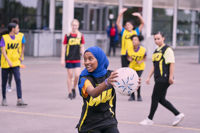
Introduction to safeguarding and welfare
Boards should ensure that effective safeguarding frameworks are in place and that staff and volunteers are sufficiently trained on their safeguarding responsibilities. While processes and education will assist in mitigating the likelihood of a safeguarding incident, the impact will always be high.
Introduction
In this section, we offer an overview of safeguarding obligations and responsibilities as well as some key considerations. However, there are specialist organisations operating in this area who have helped in authoring this section: the NSPCC’s Child Protection in Sport Unit and the Ann Craft Trust. Both of these organisations provide a wealth of guidance and resources. You are strongly encouraged to explore their websites for further information.
Sport England defines safeguarding as follows:
Safeguarding in sport is the process of protecting children and adults from harm by providing a safe space in which to play sport and be active.
It can also be useful to consider the definition applied in other sectors in order to begin to understand the breadth of the term. The NHS, for example, defines safeguarding as ‘protecting a citizen’s health, wellbeing and human rights; enabling them to live free from harm, abuse and neglect’.
There are specific legal requirements around safeguarding, which are detailed below, and the revised Code for Sports Governance increased its emphasis on the issue. This includes the requirement (4.7) that
The Board shall ensure its responsibilities towards the welfare and safety of its members and people (including but not limited to employees, participants, and volunteers) are factored into the decisions it makes and shall appoint one of its Directors to take a lead in this area.
This was in response to heightened concerns around welfare and safety in sports and activity. The safeguarding obligations of board members form part of their duty towards the wider safety and welfare of those who interact with the organisation and the oversight function should be aimed at creating a culture across the organisation where these considerations are paramount.
In addition to these requirements, there are several principles underpinning safeguarding in sports:
- Everyone has the right to enjoy sports free from all forms of abuse and exploitation.
- All athletes and participants have equal rights to protection free from harm.
- All children and adults should be encouraged to fulfil their potential and inequalities should be challenged.
- Everybody has a responsibility to support the care and protection of all athletes.
- Sporting organisations have a duty of care to all athletes who take part in sports.
Creating a safe environment is beneficial for several reasons and is one of the board’s safeguarding accountabilities which it fulfils by:
- Providing strategic support and leadership
- Identifying a safeguarding champion (the welfare and safety lead director – under the Code)
- Endorsing robust policy, procedures and plans
- Ensuring resource allocation is sufficient
- Monitoring progress, receiving and interrogating updates/reports
- Ensuring safeguarding is embedded in strategic plans and reviews (e.g. including active oversight of the risk register)
- Maximising the board’s influence in safeguarding and welfare
Boards should ensure that effective safeguarding frameworks are in place and that staff and volunteers are sufficiently trained on their safeguarding responsibilities. While processes and education will assist in mitigating the likelihood of a safeguarding incident, the impact will always be high.
It is likely that safeguarding will appear on an organisation’s risk register. However, this should not lead to a formulaic or transactional relationship with the issue: it must be lived. A culture of awareness and vigilance should be instilled at all levels of the organisation.
Creating a safeguarding culture
Safeguarding is everyone’s responsibility. This principle applies to both safeguarding children and adults.
One of the roles of the strategic leads of an organisation – the board and senior leaders – is to set the tone around the culture in that organisation. Recent failures in safeguarding in and out of sport have shown that good safeguarding practice cannot be delivered without a healthy culture and that is set at the top. This link from Bond contains a short video to explain this more clearly. Here you will also find their online tool.
An unhealthy or toxic culture is one where individuals fear speaking up, and where serious complaints will be dismissed and brushed under the carpet while inappropriate behaviour is ignored.
A safer culture is one where this does not happen. The foundations of a safer culture are to:
- Listen
An environment where everyone is confident their concerns are welcomed, listened to and addressed appropriately. - Learn
Where organisations encourage continuous learning and reflection at all levels. Applying this to improve and adapt. - Lead
Organisations should lead by example to empower everyone with the confidence to challenge and instigate change.
We join the Ann Craft Trust in asking sports and activity organisations to commit to improving their cultures. The #SaferCultureSaferSport campaign aims to provide you with all the tools you need to create a safer and more inclusive culture in your sport.
You can learn more about the campaign, access key learning materials, and make your pledge to creating safer cultures, on their #SaferCultureSaferSport hub.
Separate policies and procedures for children and adults
Many sports organisations provide services to and support both adults and children, and it may seem easier and more convenient to have a single safeguarding policy and set of procedures. This is not recommended for a number of reasons:
- Children and adults may each face a different set of issues
- The definitions and terms used differ
- The definition of a child is concrete (under 18) while the definition of an adult at risk depends upon their circumstances
- Procedures for reporting abuse and handling cases are not the same
- Safeguarding is done with adults, not to them
- Referrals following adult safeguarding concerns require the adult’s consent (unless they are assessed as not having the mental capacity to provide this) whereas referrals about safeguarding children do not need the child’s consent
- There is very different legislation and policy
- There are four legal categories of abuse for children and ten for adults
- The eligibility for criminal records checks are different
Adding safeguarding adults or adults at risk to a safeguarding children policy often dilutes the messaging about both. This is particularly likely when organisations base the policy and procedures for adults on those originally written for children.
Having separate policies and procedures will enable everyone in your organisation to be clear about how to effectively safeguard both children and adults.
